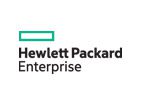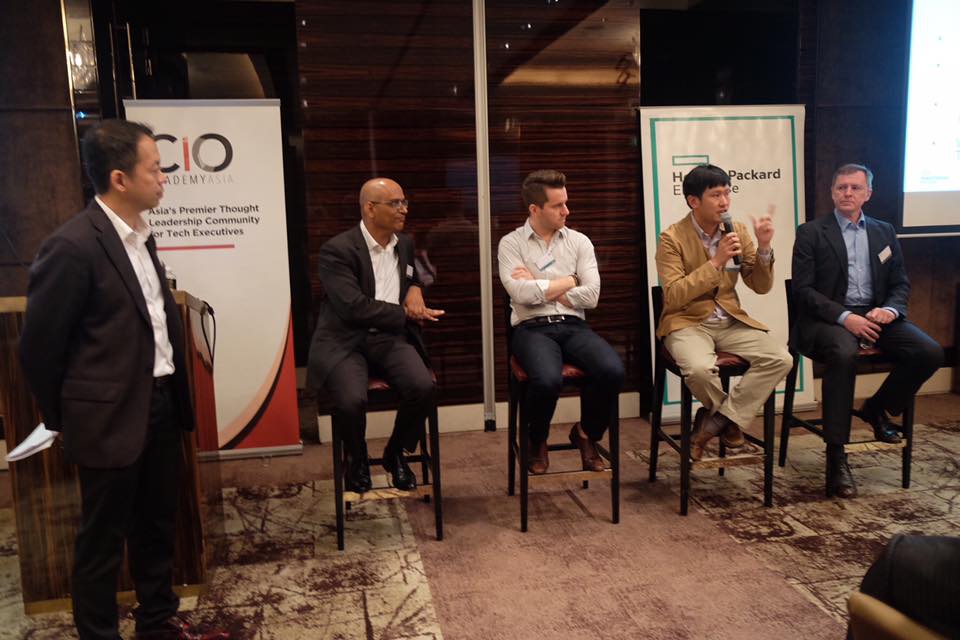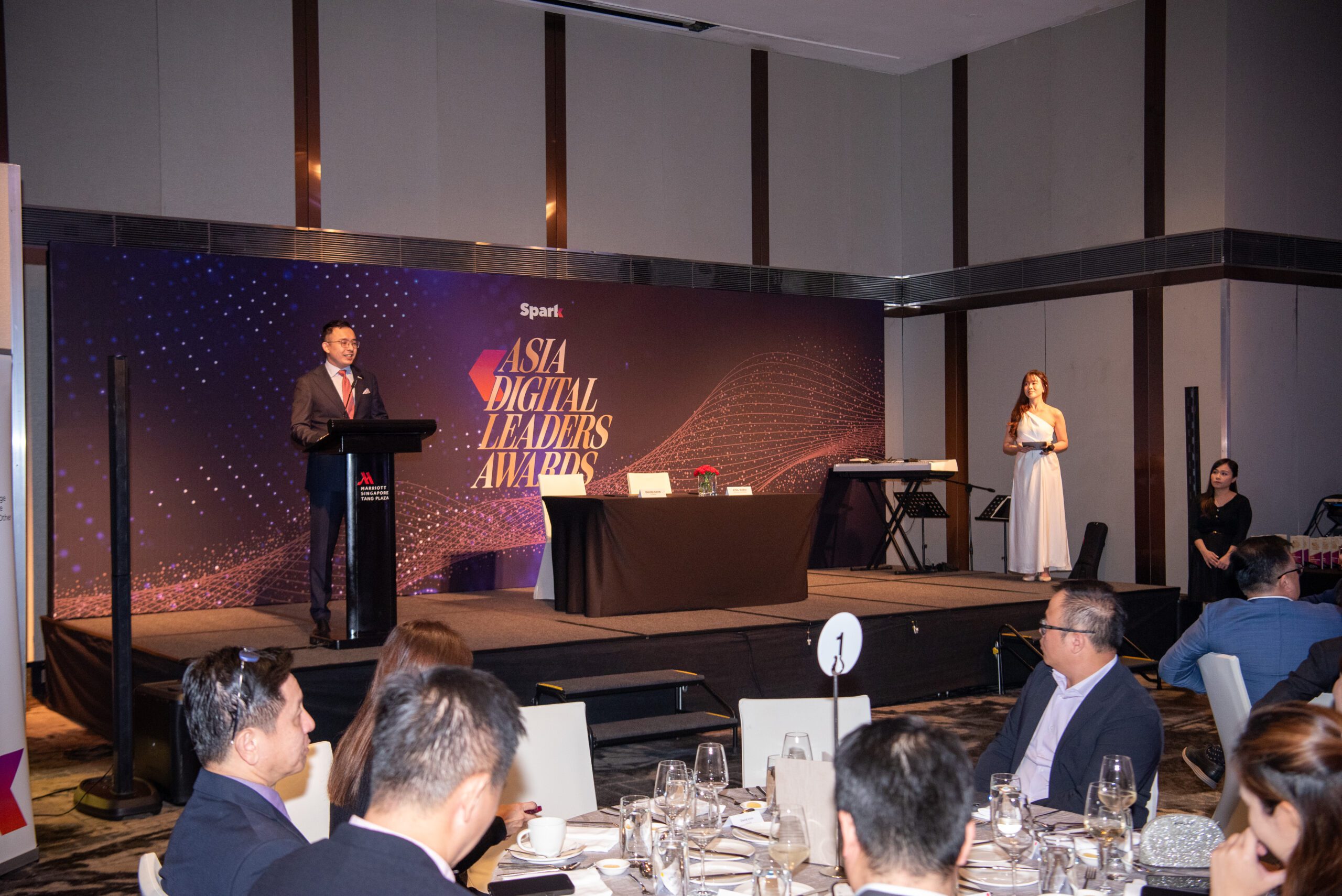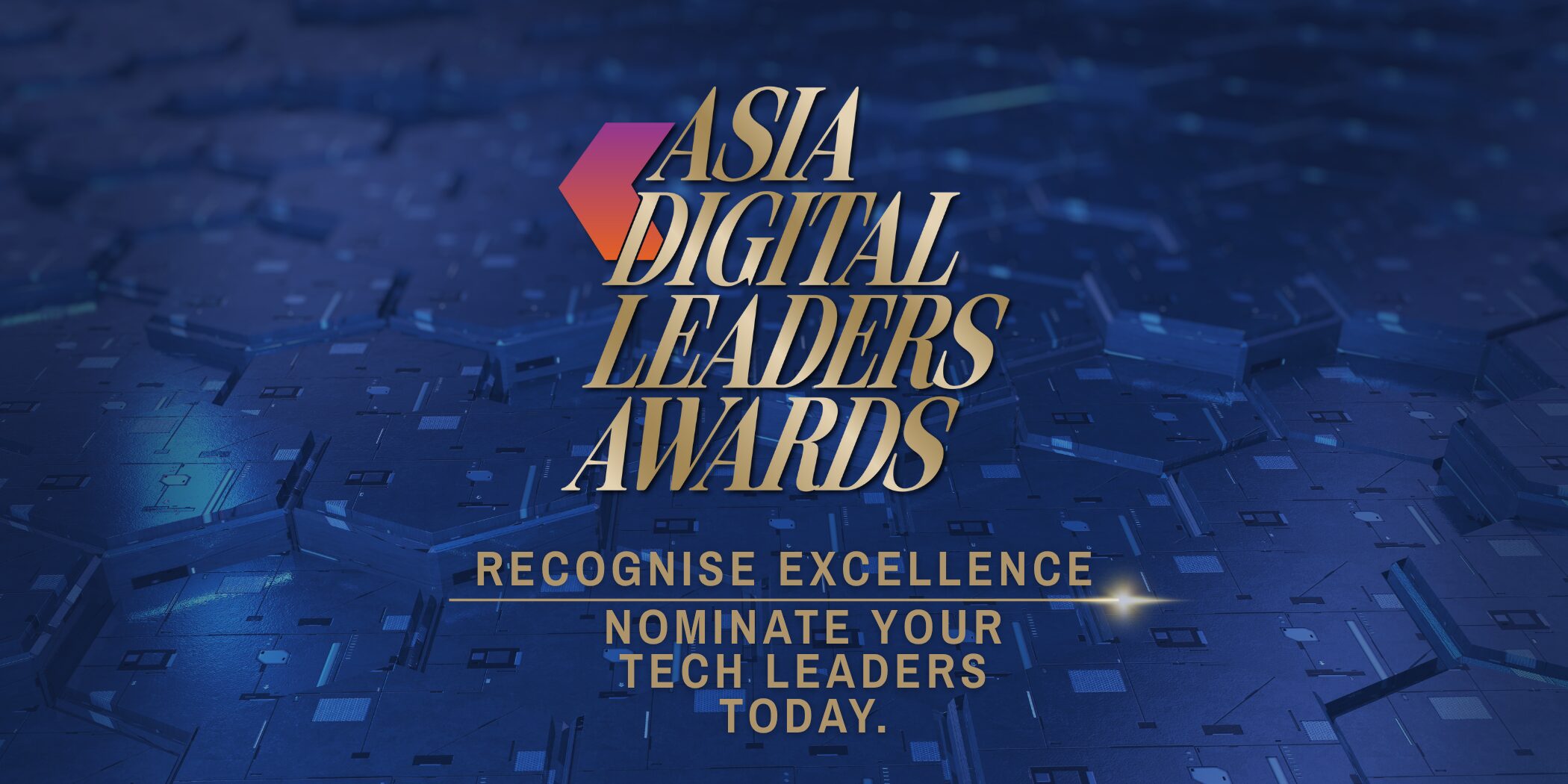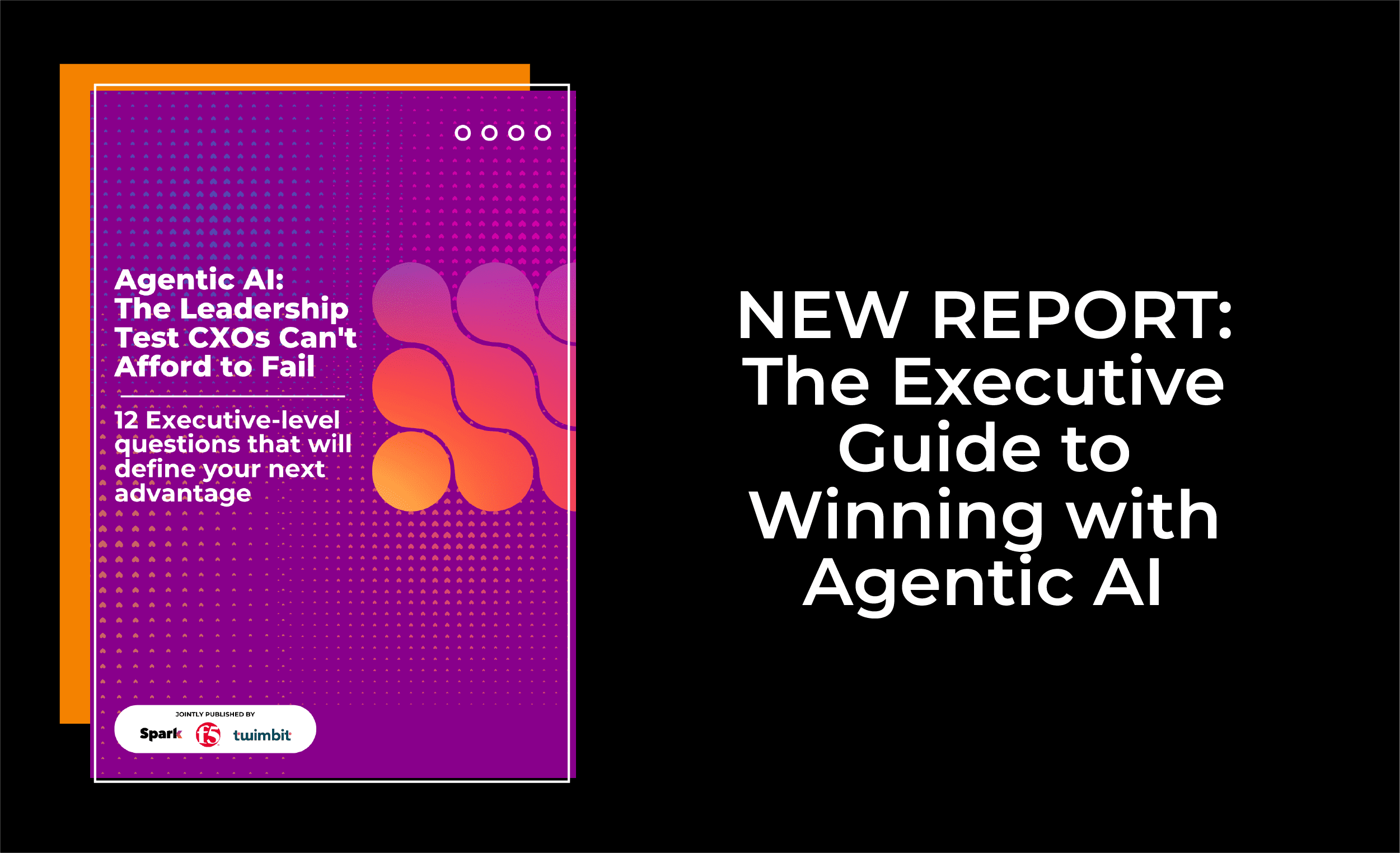5 October 2016
If the hubbub during the networking breakfast at the event’s start was any indication, participants gathered for HPE’s CXO Roundtable Discussion were definitely raring to engage and tackle the topic of disruption.
On-going Reverberations
Leading off the event, Glen Francis, President of CIO Academy Asia observed that while Uber kicked off the ride-hailing landscape, its more recent vehicular acquisitions are further up-ending the status quo for car dealers and manufacturers. By extension then, other industry sectors may also expect to see further and on-going reverberations from disruptions, which portend challenging and exciting times ahead for IT and business leaders. But their relative starting points will matter, as different approaches will apply to organisations at different stages of transformation despite commonalities in other respects.
Agility, Built on Fundamentals
The two keynote speakers from two distinctly different organizations evinced this. As a relative newcomer to the scene, 4-year-old start-up Grab has taken a highly nimble approach from the get-go, with bi-monthly reviews and revisions to business plans and a strong project-orientation as part of their modus operandi, according to Paul Hadjy, Head of IT and Information Security. Virtually all processes are run on the cloud on a SaaS basis, with vendor SLAs designed to enable easy scaling and on-boarding of new services or capabilities as needed. The need for business and operational agility implied certain requirements for network stability, infrastructural and security, which led Grab to set up and manage their networks from Singapore. More to the point, Paul stressed that beneath Grab’s high velocity veneer and disruptive approaches, some things remained fundamental from the cybersecurity perspective e.g. getting the basics right, having rigorous training for all local users, and running incident response simulations as part of ensuring readiness and internalizing training.
Meaningful Innovation & Transformation
In contrast, Singapore Post’s traditional underpinnings, institutional history, DNA and culture represented real constraints to exponential change. Instead, Head of Post Office Network and Digital Services Bernard Leong related how SingPost approached transformation in a more step-wise fashion even as the urgency of the need was widely acknowledged. Taking a strong people-centric and bias-for-action orientation, SingPost focused on empowering users, engendering trust and teamwork, and enabling top execution in designing a unified customer experience. And to better appreciate field challenges personally, he recounted his front line stint delivering parcels and mail – an experience that helped to inform his perspectives on issues faced by delivery staff.
More broadly, he stressed that innovation must be meaningful, problem-focused and not for its own sake. In practice, this meant that SingPost’s transformation needs drove the IT agenda. Bernard’s financial accountability for initiatives also made him a strong advocate for P&L responsibilities to reside with IT, as he related how it helped him articulate the agenda, value and meaning of transformation to the business.
Approaches to Disruption
Reflecting on the organizations’ contrasting approaches, HPE’s Application Services and Industry Solutions Practice Leader for APJ Andrew Clarke questioned commonplace definitions of digital disruptors that mainly saw them as asset-lite demand aggregators. Rather, their high connectivity, ability to understand customers, effective response and ability to enhance customers’ experiences were more likely the key differentiating criteria. By his reckoning, digital disruptors have wider contexts of awareness for decision making, which may be the critical difference that equips them to function in the modern zeitgeist and perform with relevance. He suggested that their advantage may be due to a certain frame of mind or philosophical stance – after all, not all digital disruptors were actually born in the digital world i.e. Amazon.com started about 20 years ago. Rather, how or whether organizations thrive today hinges on clarity as to where they have decided to go and the ability to act accordingly.
He referred to Geoffrey Moore’s disruption framework which categorized organizations’ approaches to disruption through: (1) introduction of wholesale changes in how products or services are provisioned; (2) introduction of disruptive change and then have the change trickle through the organization; (3) use of IT to enable and drive change in the organization, and (4) vesting the mandate for change in growth leaders who tend to be the ones driving digital change and disruption.
Switching gears, Andrew noted that organizations function within the larger context of their cities and industries which are also facing transformation challenges. Technology use is changing the ambit and footprint of cities in terms of their smartness in organizing themselves; those that are low in tech use or ability to organize themselves and transform thus risk shrinkage and potential decline.
Fundamentally and whether from the perspective of cities or organizations, he stressed that customers, end-users and citizens are the ones in charge and thus the final arbiters of value. To avoid obsolescence, he ventured that it would serve IT leaders well to understand end-users and incorporate their perspectives into organizations’ considerations.
Roundtable Discussions
On that note, the gathering broke for refreshments followed by roundtable discussions among mixed groups of participants from different industry sectors. The groups were assigned to address four different topics, and summaries of their discussions follow:
On the question “What does going digital really mean?”, participants assigned to the topic considered it from the perspective of expectations, in particular the notion of responsiveness and personal enablement resulting from the convenience and availability of digital services and resources. By extension, these attitudes also translate into higher performance expectations of organizations, be they services, processes or overall agility and ability to innovate. An example mentioned were the innovations in retail banking where the range of digital services available are not only enabling customers but also effectively changing the mode and culture of interaction. This in turn raises the bar on service offerings in other customer- facing industry sectors, effecting a broad digital acculturation of the public.
Participants addressing the topic “What digital initiatives are driven by different organizations and industry sectors?” ventured that the underlying commonalities of the digital initiatives among their sectors hinged on building trust and digitalizing the value chain. The latter tends to involve transaction automation along with enhancements to retail experiences, where the focus is less on technology per se and more on the business and process streams of accomplishing tasks.
Among the public sector participants, they noted that their thrust of innovations centred around collaborations where challenges pertained to addressing different mind-sets. There was broad agreement that transformation needs to be at the human level and also attune to internal customers in order to be effective, just as there was wide agreement that external customers and their needs must be the drivers of business transformation strategies and initiatives. To that end, external consultants were also seen as potential sources of influence and new insights who could stimulate thinking within public sector agencies.
Moving on to the question “How to keep up with increasing digital needs of customers?”, group participants agreed that it was necessary to go beyond merely knowing customers to engaging them meaningfully and understanding what they truly needed. In the context of education and the younger generation, more training for teachers and staff was also felt to be necessary to better engage the young; engagement in this regard pertained to cultural and qualitative dimensions of understanding and communication that may not necessarily be captured in surveys or broad data analytic approaches.
More broadly, the group also considered the implications of engaging both internal and external customers’ growing and changing digital needs from a global strategy perspective and down to the local level. They saw story-telling and strong narratives to be increasingly important in building digital experiences, creating the contexts and dynamic for better digital engagement, and more compelling corporate or brand reputations built on quality and image. Closer to home, many also agreed that getting this right could also have useful implications for improving employee productivity.
Addressing the final question “What does the future hold for digital transformation?”, participants were unanimous in expecting it to be strongly customer-driven, meaningfully experience-driven through relevant channels e.g. mobile, and more finely attuned to customer attributes or needs e.g. age or lifestyle considerations. However, more perils in the digital landscape were also expected, as security and other threats continue to loom large. The recent controversial measure to block Internet access for Singapore civil servants was mentioned as an example of a type of response to security threats. Acknowledging that while some might deem it drastic, participants nonetheless recommended looking beyond the controversy to consider wider implications and weigh its merits.
Rounding out the discussions, participants considered the implications and progress of digital transformation across a wide swath of industries and notionally ranked them on a transformation spectrum. They concluded that all were struggling to some degree but notwithstanding their varying attitudes and progress on the spectrum, transformation was widely recognized to be necessary. As such, questions likely to be raised going forward would be along the lines of “What has digital done FOR them?” and “What has been done TO them by embracing digital transformation?”
Collaboration was seen to be increasingly key to thriving and survival in this landscape but while industries higher on the transformation spectrum would be readier to do so, legacy or traditional organizations are likely to have a competitive zero-sum mind-set and would thus either resist or attempt to fight it out. To that, participants spoke of the value of having an open mind-set and willingness to adjust organizational strategies to remain relevant.
Questions & Answers
Concluding the session, the speakers from Grab, Singapore Post and HPE took questions from the audience
– the first of which was: How would start-ups like Uber be likely to disrupt the traditional car markets?
Upping the Ante, by Moving Up the Value Chain
Paul Hadjy of Grab remarked that the resulting increase in competition will necessitate greater collaboration and partnerships with others to improve their offerings and thus retain competitive. Bernard Leong from SingPost ventured that there could be new ways of looking at it from value chain perspective
i.e. how players in the sector could seek to move up the value chain by offering downstream or upstream services, leveraging digital interactions beyond the car as an asset, and exploring integrated aspects of services e.g. data on tracked usage, performance analytics etc.
Asked provocatively as to what they would recommend if approached by a car dealership facing the aforementioned quandary, Andrew Clarke of HPE responded that a differentiation strategy would be necessary in the context of competition that threatens to start a race to the bottom. The advantage would depend on their ability to develop distinctive service models and solution sets that generate value, build customer trust and loyalty, and create opportunities through digital capabilities. His anecdote about his car servicing company in Australia was telling, as they were able to advise and provide data-driven predictive and performance feedback on his vehicle that proved useful when he had to make decisions on car maintenance.
Innovating Under Useful Constraints
On a question about driving innovation in business areas that may not be considered an organization’s aspects of core competence, Bernard recounted the example of SingPost’s digital platform SAM as an initiative that was initially ‘co-opted’ under the mantle of a P&L driven business unit. The context for enabling innovation development and need to demonstrate results with bottom-line outcomes were key factors driving the value of innovations, said Bernard, not least because the co-optation arrangement forced innovation managers to work with internal partners and mutually stretched their possibilities.
Paul agreed, noting that many start-ups currently had the luxury of operating without P&L performance pressures but could face serious challenges as they mature, especially without having experienced the discipline of P&L accountability. To this point, he suggested there may be a need to co-opt and mentor young and promising start-up and tech leaders who will need to operate under real market conditions.
Technology IS the Business
He further accentuated the point in response to a question about reconciling perceptions of Technology as being separate from the Business. As organizations increasingly appreciate technology’s value and importance to business, there is no better time to make the case that technology IS the business and not merely a glorified aspect of it. He pointed out that even traditional institutions like Goldman Sachs are rebranding themselves as a technology company.
Beyond branding, there should be better alignment between technology’s deliverables and business’ P&L accountability. To be in a position to do so, IT must assuredly deliver and get the fundamentals right, such as ensuring basic hygiene factors and selecting appropriate technology assets to ensure security for business operations.
Normalizing Disruptions
The speakers noted that there will come a time when today’s disruptors become tomorrow’s legacy companies as newer innovations and developments over-take them. Their continued relevance then will likely be a matter of degree, subject to whether they are fast followers or builders. Bernard intoned that they would have to balance between being driven by value and having viable business cases for customers. He was also quick to debunk the widespread notion that fast technology adoption was necessarily a good thing, as lower tech but more relevant options can be a smarter business choice. As such, business needs should be the determinants of tech relevance; he also suggested that business could test-drive and invest in smaller-scale or lower cost technology options as a way to determine to what or if they could develop in- house and build the capabilities that the business truly needs.
Persuading with a Sharpened Tool
Rounding out the Q&A session was the perennial but no less thorny question of how IT could convincingly make the case for innovative technology investments or projects in the absence of immediate or clearly demonstrable ROI. As it stands, IT leaders continue to struggle for resources to deliver strategic IT initiatives against other competing and more clearly ROI-generating business initiatives. To this, it was noted that resource justifications for IT tend to be easier when initiatives already had buy-in from other organizational leaders beyond IT.
The speakers proposed positioning technology as a tool for business i.e. a necessary foundation that can enable business growth and optimization. Framed as a strategically-directed tool that can provide a business edge, this view of technology may not be new in itself but as Bernard suggested, a corollary albeit expedient recourse may be to disrupt the traditional line of P&L responsibility by assigning it to the IT or digital guy.
Aiding & Abetting Disruption
Noting on the side-lines as the event concluded and in the midst of high- spirited last minute networking among attendees, Glen commented that the range and quality of questions and discussions were strong indicators that the complexities and approaches to disruption are clearly in the forefront of IT and business leaders’ concerns. As such, gatherings of this nature among IT and business leaders will not only be useful platforms to view how conversations in this space play out; with like-minded partners, it would also likely have a role in informing the courses taken by disruptors in their midst.
– By Jane Siow, for CIO Academy Asia
To view the PDF version of this report, please visit here.
Glen Francis
President, CIO Academy Asia
Paul Hadjy
Head of IT and Information Security, Grab

Bernard Leong
Head of Digital Services, Singapore Post
Partners
